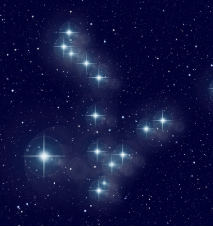
Stargazing with Star Chart

Overview
Star Chart is an app for your iPad or Android device. Students can learn about constellations by aiming their phones at the night sky. There are additional features that allow students to interact with facts about planets and space discovery.
Learning Objectives
Students will:
- Be able to use the Star Chart app to map out constellations in the sky.
- Be able to recognize constellations and name them
- Be able to understand that some stars and/or groups of stars (e.g., constellations) can be seen in the sky all year, while others appear only at certain times of the year.
Vocabulary
Vocabulary Words:
- Constellation: A constellation is a group of stars visible within a particular region of the night sky that appears to form a pattern.
- Axis of the Earth: The axis of the earth is an imaginary line around which the earth rotates. It passes through the north pole, the center of the earth and south pole.
- Equator: An equator is an invisible line that divides a globe into two parts, north and south.
- Northern Hemisphere: The northern hemisphere Is the hemisphere that is to the north of the equator
- Southern Hemisphere: The southern hemisphere is the hemisphere to the south of the equator
- Nova: A nova is a star that suddenly increases in brightness in just a few hours or days
- White Dwarf: A white dwarf is a small dense star.
- Parallax: A parallax is an apparent change in the position of a star due to the change in the Earth's position as the Earth moves around the sun.
Pre-planning
To prepare for this lesson:
-
Watch the star chart video tutorial.
-
Some helpful tips on the star chart can be found on this website.
-
Decide what devices (how many) to download Star Chart.
-
Decide if you want students in groups, partners or solo.
-
Watch the Constellations for Kids video.
-
At this point, your students should have some knowledge of space
Additional Resources
Accommodations
See Accommodations Page and Charts on the 21things4students.net site in the Teacher Resources.
Steps
Directions for this activity:
-
Begin with this video tutorial.
-
Have a conversation with your class.
-
What constellations did you see?
-
Are there some you did not see? Why?
-
-
Show the Constellations Video on why you see what you see in the sky
-
Discuss the video afterward.
-
Students will then use the Star Chart Google Doc to map out what they see in the sky. (They will need to have their own copies. If the teacher uses Google Classroom the document can be pushed out to the students. )
Assessment Options
Different options for assessing the students:
- Observations
- Check for understanding
-
Students will turn in the worksheet with their findings.
MITECS COMPETENCIES & ISTE STANDARDS
MITECS: Michigan adopted the "ISTE Standards for Students" called MITECS (Michigan Integrated Technology Competencies for Students) in 2018.
Knowledge Constructor
3a. Students plan and employ effective research strategies to locate information and other resources for their intellectual or creative pursuits.
3b. Students evaluate the accuracy, perspective, credibility and relevance of information, media, data or other resources.
3c. Students curate information from digital resources using a variety of tools and methods to create collections of artifacts that demonstrate meaningful connections or conclusions.
Devices and Resources
Device: PC, Chromebook, Mac, iPad
Browser: Chrome, Safari, Firefox, Edge, ALL
App, Extension, or Add-on:
Websites:
Constellations for Kids
CONTENT AREA RESOURCES
ELA
Write about a constellation or write a short story on a constellation.
Integrated Arts
Find a series of stars and create your own drawing.
Science
Explain what stars you can find? Why can you see these stars?
Social Studies
Find a Myth on a Constellation and share it in class.
Credits
This task card was created by Courtney Conley, Utica Public Schools, January 2020. Updated April 2022.


